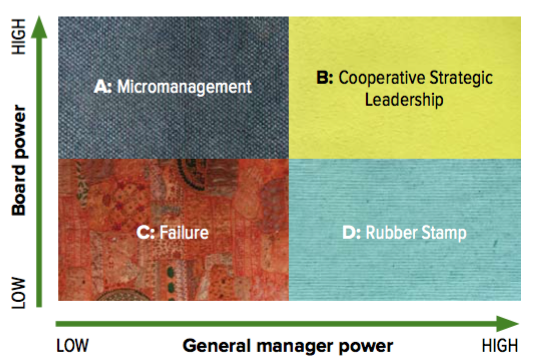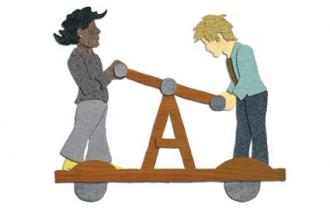Power Triggers, Seesaw Battles and Handcar Cooperation


Most would agree that a healthy board-general manager relationship not only makes the co-op run more smoothly, it is a critical connection between member-owners and operations in our democratically controlled organizations.
Yet the health of this working relationship often remains elusive or at least can come under stress. It can "turn on a dime at election time" or when a difficult situation arises. Many things may lead to a downhill slide or a shaking of the relational foundations. This is not at all inevitable. My aim here is to provide insight that will aid in maintaining a healthy board-GM relationship.
In this article, I argue that one important cause of such problems is the accepted view of power by both the board and management as a seesaw battle of "Us vs. Them"—rather than handcar cooperation where all have the ability to get things done. I will start with a discussion of power triggers and paradigms, followed by a comparison of the seesaw and handcar approaches to power management, and conclude with some thoughts to spark discussion.
Power paradigms and triggers
Something happens. It might be a poor financial report. Perhaps the board has been approached by a disgruntled member-owner or employee. Maybe a new director with a new agenda has been elected. Or it may simply be that the board senses they should be doing something…anything. These are all "power triggers" that lead to boards powering up to take action.
This alone is neither good nor bad. Rather, it's what's done with this fluctuating power level that matters—and this is likely driven by the paradigm of power held by the board and general manager.
Power. How does that word strike you? For many, it elicits a strong negative reaction: Scary. Abusive. Not to be trusted. And because power can be scary, abusive, and hard to trust, either it should be eliminated totally or, if it is to exist, better for "Us" to have it than "Them."
The quarant graph above shows different power paradigms for co-op boards and GMs. When neither the GM nor the board has much power (quadrant C), the business is headed for failure. With a micromanaging board (A), the board dominates. Under a rubber-stamp board (D), the GM dominates. What is the problem with these situations?
The problem is that we need our leaders to make things happen. Holding the perspective that power is "bad" leads to cycling through negative power imbalances between the board and GM. The result is tension, shattered trust, political maneuvering, and poor performance.
An alternate paradigm is that power is the ability to get things done. Defining it in this way immediately sheds light on the problems with quadrants A, C and D. What do we call it if no one has the ability to get things done and no one is empowered: failure. What do we call it if the board has all the power and the GM has none: micro-\management at best and operational chaos at worst. And if the board is weak and the GM has the power: a rubber stamp, or some might even say a benevolent dictatorship with no checks.
Because both micromanaging and rubber stamp boards are unbalanced, board-GM relations tend to go though extreme swings, resulting in an unhealthy power cycle and erosion of the relationship. The place to be that makes the most sense is shared strategic leadership (quadrant B), where both board and management are powerful enough to get things done, albeit different things.
But achieving this is easier said than done.
Power triggers tend to shift board postures. Below I describe negative postures more fully and show that they focus on the "other" party rather than on the challenge or problem. The board's focus is determined in part by the accepted paradigm of power, as summarized in the chart.
The rest of the article concentrates on boards, but clearly board postures have their counterparts for GMs. It takes both to build a healthy relationship.
Seesaw battles: Us vs. Them
In a seesaw battle, when a power trigger occurs, the focus of the board goes toward the GM's power and how there is an imbalance. Board members believe this is the critical issue that must be addressed and where resources should be expended. And having that focus leads to trouble. Let me illustrate; ask yourself if any of it sounds familiar.
Posture 1: Passive. The board has been accepting monitoring reports for years without question. Perhaps things have been good, and folks remember when the board dinners were not as pleasant and the meetings full of tension. Don't rock the
boat. Enter power trigger #1: an angry owner sends an anonymous letter to the board alleging inappropriate activity. The board grows uneasy that they have been asleep at the wheel. If this is going on, what else aren't we being told?
Posture 2: Passive-Aggressive. The tone in the boardroom is conflicted. More information is being asked for, data is questioned. The GM asks, why would you want that? The board in turn wonders why the GM would ask us why we would want that? Board members begin to look at the GM with suspicion (and vice versa) but don't really know what to do and start to fear they have not been doing their job. Angry grumbles come out, along with uncertainty.
Posture 3: Aggressive. The board election takes place, and a firebrand gets elected who knows disgruntled member-owners. Enter power trigger #2: there will be change—the board is in charge and the GM will listen! This firebrand convinces others that this power relationship has to flip in their favor. It should be this way because aren't we the trustees and supposed to be on top of all the activities of the co-op? Special meetings are called, and lots of executive sessions. The offensive to wrestle power from the GM has begun. The GM notices and counters with defense. Political maneuvering, information withholding, lawyer calling, and trust erosion occur on both sides.
Posture 4a and 4b: Infighting or Super Cops. The board may go one of two directions. One, factions may form, with some taking the GM's side. This then results in the board turning on itself, creating battles for internal board power. Two, the board unites against the GM and builds in new policy, inspections, and connections to staff to get what they feel they need to control the GM. Special oversight committees are formed to audit and inspect. The war is on, and the co-op is taking all the collateral damage.
Either the GM will exit when he or she has had enough, the board will exit when it has had enough (or gets scared enough that they will be in legal trouble from being asleep at the wheel or from the legal action on the part of the GM), or some combination of these will happen. The co-op's reputation as a great place to work is severely damaged, resulting in difficulty recruiting board members and general managers. Interestingly, after it is done, the board often says, "Never again!" and goes back to a passive posture to keep the peace—or continues as super cops and watches as GMs come and go like the seasons.
Although this summary may sound extreme, all the components are taken from a combination of real cases from food cooperatives. And while I have concentrated on the board's postures and actions, GMs have the potential to contribute their fair share to the dysfunction by sidelining the board (feed them, pat them on the head, and keep them in the dark) or playing board members against one another.
A healthier alternative
In most cases, we are dealing with good people trying to do a good job. The problem here is less that the people are bad and more that there is the continued acceptance of the seesaw paradigm of power by leaders who think that it must be Us vs. Them.
What to do? The solution is to get into quadrant B, where both the GM and board of directors are powerful enough to get their jobs done. The power may still fluctuate, but rather than the seesaw you have a cooperative railroad handcar moving in one direction. This happens because when there is a power trigger, the focus goes on the challenge or problem rather than the power of the other party. Powering up is done with the intent to make wise decisions and solve the problem—requiring each party to exercise the power needed. Power building is a part of a successful process rather than the aim.
I call quadrant B "Cooperative Strategic Leadership," which involves several elements that will be more fully discussed in a future article. For now, we will focus on critical answers to this foundational question: What is needed for both the board and the GM to each have power and, therefore, the ability to get their own things done?
Role clarity, knowledge, and preparation
The first need is role clarity. The board and GM must be very clear on their unique roles and how they interact with one another. While the roles may be unique, the board and GM may very well work together on a variety of the elements in strategic leadership.
The second is knowing what actually needs to be done in each of their roles. For the board, it is mostly making decisions including strategic direction for the co-op, policy decisions to guide the co-op's operations, and deciding whether operational performance (both results and conduct) complies with policy. The GM needs to know how to give the board what it needs to do its job, how to follow the guidance of board leadership, and of course to lead the co-op toward success.
The third is preparing to make the knowable as well as unexpected decisions so that they actually provide wise leadership. This involves knowledge building and practice. It also involves building the tools and processes needed to facilitate successful decision-making and leadership.
If both the board and GM build understanding around the utility of shared empowerment and address these three points, then the chances of power triggers resulting in a negative board posture cycle will diminish significantly. The board and GM gain insights about power, role clarity, and preparation, thus building the foresight that triggers will inevitably come. The board can be prepared to handle them in a healthy way that allows for intentional and effective power sharing.
When a trigger occurs, the board recognizes it and powers up by figuring out what it needs to know to make a decision and then making it. This is true be it a staff grievance, a poor financial report, or even a good financial report (retain those patronage dividends?).
So what is your paradigm? Your board's? Your GM's? I suggest you invest some collaborative training time to build shared understanding on these issues—with the intent to build a healthy and long-lasting relationship where the board and GM are working in a respectful, candid, and cooperative way. With good will, practice, and focus on process, your food co-op board and GM can start pumping powerfully and head down the rails together.
Questions for discussion and training
- What might be power triggers for your board? Have any occurred in the past? What happened?
- Have you witnessed a seesaw battle in a co-op—or, by contrast, handcar cooperation? What was the impact on the board, the GM, the co-op as a whole?
- Which paradigm does it make sense for your board and GM to build into your culture?
- Can you improve role clarity for the board and GM? What tools do you already have at your disposal?
- Can you identify what decisions your board needs to make in order to fulfill its leadership role?
- What steps can you take to train yourselves through knowledge building and practice to be prepared to make these leadership decisions wisely?







